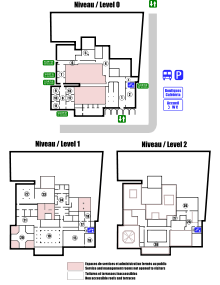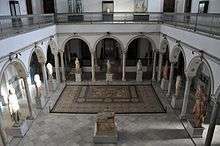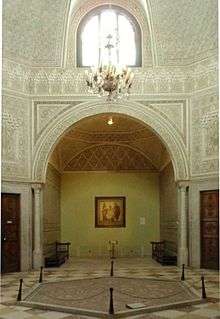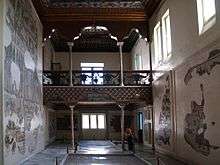Bardo National Museum
| |
 Carthage Room, Bardo National Museum (2005) | |
| Location | Tunis, Tunisia |
|---|---|
| Type | National museum |
| Curator | Taher Ghalia |
| Website |
www |
The Bardo National Museum (Arabic: المتحف الوطني بباردو; French: Musée national du Bardo) is a museum located in Tunis, Tunisia. It is one of the largest museums in North Africa.
Location and description





The Bardo National Museum building was originally a 15th-century Hafsid palace, located in the suburbs of Tunis.
The Bardo is one of the most important museums of the Mediterranean basin, and the second largest on the African continent after the Egyptian Museum. It traces the history of Tunisia over several millennia and through many civilizations through a wide variety of archaeological pieces. Being in the former palace, it offers many major works discovered since the beginnings of archaeological research in the country. Originally called Museum Alaoui (المتحف العلوي), the name of the reigning bey at the time, it has had its current name of Museum of Bardo only since the country's independence.
In addition to famous works such as the Blue Koran of Kairouan, the Islamic Department contains a collection of ceramics from North Africa and Asia Minor.
The Bardo brings together one of the finest and largest collections of Roman mosaics in the world thanks to the excavations undertaken from the beginning of the 20th century on archaeological sites in the country including Carthage, Hadrumetum, Dougga, or Utica. The mosaics represent a unique source for research on everyday life in Roman Africa. The Museum also contains a rich collection of marble statues representing the gods and Roman emperors found on various sites including those of Carthage and Thuburbo Majus.
The Bardo has also rich pieces discovered during the excavations of Libyco-Punic sites including mainly Carthage, although the Carthage National Museum also possesses an important collection. The main parts of this Department are grimacing masks, terracotta statues and stelae of major interest for the Semitic epigraphy, the stele of the priest and the child being the most famous. The Museum also houses Greek works discovered in particular in the excavations of the ship of Mahdia, whose iconic piece is a marble bust of Aphrodite.
The museum underwent a major refurbishment, completed in 2011, that was interrupted due to the Tunisian revolution.
Collections
It contains a major collection of Roman mosaics and other antiquities of interest from Ancient Greece, Carthage, Tunisia, and the Islamic period.
The museum displays objects ranging from pre-historical artifacts to modern jewellery.
2015 terrorist attack
On 18 March 2015, 24 people were killed in a terrorist attack [1][2] when three terrorists in civil uniform attacked the Bardo National Museum in the Tunisian capital city of Tunis, and took hostages.[3] Twenty-one people, mostly European tourists, were killed at the scene, while an additional victim died ten days later. Around fifty others were injured. This attack took place after the famous Charlie Hebdo attack in Paris where many journalists were killed [1][2][4] Two of the gunmen, Tunisian citizens Yassine Labidi and Saber Khachnaoui, were killed by police, while the third attacker is currently at large.[5] Police treated the event as a terrorist attack.[6][7] It was the deadliest terrorist attack in Tunisian history; surpassing the 2002 Ghriba synagogue bombing, which killed twenty-one people, most of whom were also European tourists, and injured more than thirty others.[4][8]
The Islamic State of Iraq and the Levant (ISIL) claimed responsibility for the attack. Many Tunisians were praised by the tourists for saving many lives.
Gallery
- Famous Mosaic
-

Detail of the Ulysses Mosaic
-
015(js).jpg)
Ulysses Mosaic
-

Neptune Roman Mosaic
-
Zodiac mosaic
-

SeignorJulius mosaic, 5th CE, Carthage
-

Matron at her toilet, 4th c. CE Carthage
- Pieces in The Ground Floor
-

The Early Christian Room with Baptistery in The Centre.
-
Museum Entrance.
-
Hallway of Sarcophagi Full with Visitors.
-
Access Door on the First Floor.
- Roofs of Oudna Room
-

Painted Ceiling of The Oudna Room.
-

Painted Wooden Ceiling.
-

Painted and Gilded Ceiling of The Room Althiburos.
See also
References
- 1 2 "The Latest: French President Mourns Tunisia Victims". nytimes.com. 18 March 2015. Retrieved 19 March 2015.
- 1 2 "Museum attack a 'great calamity' for Tunisia's young democracy". latimes.com. 18 March 2015. Retrieved 19 March 2015.
- ↑ "Thousands of Tunisians, leaders march after Bardo attack". Reuters. 29 March 2015. Retrieved 29 March 2015.
- 1 2 Death toll rises to 23, msn.com; accessed 19 March 2015.
- ↑ "Third Tunisia museum attacker 'on the run', says president". Yahoo! News. March 22, 2015. Retrieved March 22, 2015.
- ↑ "21 dead in Tunisia attack, Including Gunmen". aljazeera.com. Retrieved 19 March 2015.
- ↑ Marszal, Andrew (18 March 2015). "Gunmen 'take hostages' in attack on Tunisia parliament.". The Telegraph. Retrieved 18 March 2015.
- ↑ "Tunisia Museum Attack Is Blow to Nation's Democratic Shift". New York Times. 18 March 2015. Retrieved 19 March 2015.
External links
| Wikimedia Commons has media related to Bardo National Museum. |
Coordinates: 36°48′33.79″N 10°08′04.23″E / 36.8093861°N 10.1345083°E